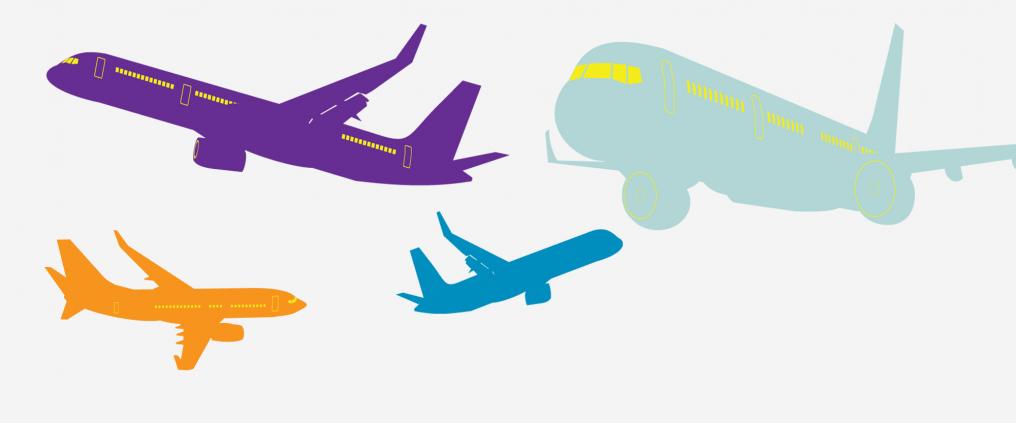The control tower
Every airport has a control tower. Here, air traffic controllers manage the traffic's time and order. This involves 'sequencing' for aircraft using the taxiways, runways, and the skies near the airport.
Air traffic controllers work from a tower because this vantage point lets them see the planes they manage and thus allows them to operate as efficiently and safely as possible. All air traffic control functions rely strongly on technology, especially in adverse weather conditions.
All airborne planes close to the airport are shown on a single radar screen, and the ground radar shows all traffic in the airport area to one-metre accuracy.
Aircraft and ground vehicles are permitted to use the taxiways and runways only after receiving clearance from air traffic control.
Thanks to the collaborative decision-making (CDM) method adopted at Helsinki Airport, aircraft wait at their gates with engines turned off until space is ready for them on the runway. This method makes air travel more efficient by enhancing the co-operation among the various parties involved in the process between the landing and departure of aircraft.
It enables the aircraft to proceed smoothly to takeoff right after being given clearance for taxiing and takeoff. This is an important factor, because the logistics requirements are tight: each year, up to 87,000 flights leave from Helsinki Airport.
Approach Control
Busy airports have an approach control unit in addition to the control tower. Finnish airports with this additional unit are those of Helsinki, Tampere, Jyväskylä, Kuopio, and Rovaniemi.
But what is approach control? This process guides the incoming traffic towards the airport and sequences approaching aircraft into a queue, also ensuring that the departing aircraft is heading in the right direction and stay in the right order until they become the responsibility of area control, described next.
Pilots are responsible for the safe piloting of their aircrafts. The pilot of a plane taking off contacts approach control when reaching a height of approximately 500 metres.
The approach control personnel's watchful eyes remain on the aircraft departing from an airport such as ours for some 100 kilometres, after which the aircraft are directed by the appropriate area control centre as long as they remain in Finnish airspace or until they approach a domestic destination airport.
Helsinki Airport came in fourth in a comparison of airport fees at 24 major European airports.
Area Control
The area control monitors all aircraft in Finnish airspace, giving each aircraft flight altitude, speed, and direction instructions that it must follow.
Each country is responsible for monitoring its own airspace, so guidance is given for an aircraft reaching a national border from one country's area control centre to that of the neighbouring country.
Then, the traffic controllers use their radar display system to record the aircraft as handed over to the next nation's area control centre, whereupon the receiving facility confirms receipt of the aircraft. Handover is also announced to the pilot by radio, and the pilot is requested to contact the new area control centre by radio.
Sufficient distance
Air traffic controllers are responsible for traffic separation and sequencing. Pilots have their own systems for detection of nearby aircraft, in case the air traffic controllers become unable to direct air traffic under exceptional circumstances.
The minimum distance between aircraft approaching an airport at the same altitude and advancing in the same direction is 5 km.
The sequencing distance can be significantly less when air traffic controllers can monitor the planes under their control visually from the tower.
Further from airports – that is, for area control – the minimum sequencing distance maintained is normally around nine kilometres and the minimum vertical distance 300 metres.
European airspace
European airspace has traditionally been divided into country-specific sectors, with each country responsible for its own air traffic control.
The EU has set the objective of creating a continent-wide common airspace, referred to as Single European Sky (SES), for purposes of increasing the capacity of air traffic control, enhancing safety, and improving cost-efficiency, alongside contributing to making air traffic more environment-friendly.
The project divides Europe into areas referred to as 'functional airspace blocks', or FABs. Finland belongs to the North European block, NEFAB, together with Norway, Estonia, and Latvia. One of the aims with SES is to provide air traffic control services within a common, integrated airspace from 2015.
Finavia's air traffic control organisation is staffed by 460 employees, roughly half of them air traffic controllers. The company invests significantly in further development of these operations, to ensure that it will provide reliable, high-quality air traffic control services far into the future.
Text: Sami Laakso
Illustration: Jaska Poikonen



